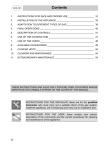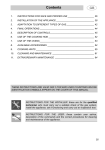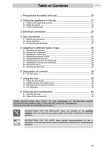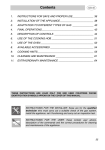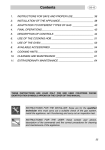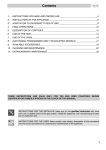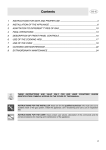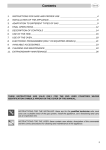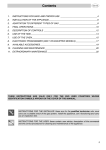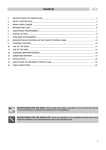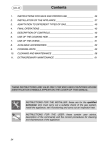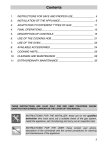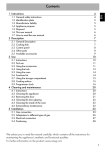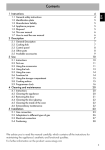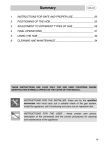Download Smeg CS71-5
Transcript
Contents 1. INSTRUCTIONS FOR SAFE AND PROPER USE _____________________ 32 2. INSTALLATION OF THE APPLIANCE ______________________________ 34 3. ADAPTATION TO DIFFERENT TYPES OF GAS______________________ 36 4. FINAL OPERATIONS ___________________________________________ 38 5. DESCRIPTION OF CONTROLS___________________________________ 39 6. USE OF THE COOKING HOB ____________________________________ 45 7. USE OF THE OVEN ____________________________________________ 46 8. AVAILABLE ACCESSORIES _____________________________________ 47 9. COOKING HINTS ______________________________________________ 48 10. CLEANING AND MAINTENANCE _________________________________ 52 11. EXTRAORDINARY MAINTENANCE _______________________________ 55 THESE INSTRUCTIONS ARE VALID ONLY FOR END USER COUNTRIES WHOSE IDENTIFICATION SYMBOLS APPEAR ON THE COVER OF THIS MANUAL. INSTRUCTIONS FOR THE INSTALLER: these are for the qualified technician who must carry out a suitable check of the gas system, install the appliance, set it functioning and carry out an inspection test. INSTRUCTIONS FOR THE USER: these contain user advice, description of the commands and the correct procedures for cleaning and maintenance of the appliance. 31 Introduction 1. INSTRUCTIONS FOR SAFE AND PROPER USE THIS MANUAL IS AN INTEGRAL PART OF THE APPLIANCE AND THEREFORE MUST BE KEPT IN ITS ENTIRETY AND IN AN ACCESSIBLE PLACE FOR THE WHOLE WORKING LIFE OF THE COOKER. WE ADVISE READING THIS MANUAL AND ALL THE INSTRUCTIONS THEREIN BEFORE USING THE COOKER. ALSO KEEP THE SERIES OF NOZZLES SUPPLIED. INSTALLATION MUST BE CARRIED OUT BY QUALIFIED PERSONNEL IN ACCORDANCE WITH THE REGULATIONS IN FORCE. THIS APPLIANCE IS INTENDED FOR DOMESTIC USES AND CONFORMS TO CURRENT REGULATIONS IN FORCE. THE APPLIANCE HAS BEEN BUILT TO CARRY OUT THE FOLLOWING FUNCTIONS: COOKING AND HEATING-UP OF FOOD. ALL OTHER USES ARE CONSIDERED IMPROPER. THE MANUFACTURER DECLINES ALL RESPONSIBILITY FOR IMPROPER USE. DO NOT LEAVE THE PACKING IN THE HOME ENVIRONMENT. SEPARATE THE VARIOUS WASTE MATERIALS AND TAKE THEM TO THE NEAREST SPECIAL GARBAGE COLLECTION CENTRE. IT IS OBLIGATORY FOR THE ELECTRICAL SYSTEM TO BE GROUNDED ACCORDING TO THE METHODS REQUIRED BY SAFETY RULES. THE PLUG TO BE CONNECTED TO THE POWER CABLE AND THE SOCKET MUST BE THE SAME TYPE AND MUST CONFORM TO CURRENT REGULATIONS. THE SOCKET MUST BE ACCESSIBLE AFTER THE APPLIANCE HAS BEEN BUILT IN. NEVER UNPLUG BY PULLING ON THE CABLE. IMMEDIATELY AFTER INSTALLATION CARRY OUT A BRIEF INSPECTION TEST OF THE APPLIANCE, FOLLOWING THE INSTRUCTIONS BELOW. SHOULD THE APPLIANCE NOT FUNCTION, DISCONNECT IT FROM THE SUPPLY AND CALL THE NEAREST TECHNICAL ASSISTANCE CENTRE. NEVER ATTEMPT TO REPAIR THE APPLIANCE. ALWAYS CHECK THAT THE CONTROL KNOBS ARE IN THE POSITION (OFF) WHEN YOU FINISH USING THE HOB. NEVER PUT INFLAMMABLE OBJECTS INTO AN OVEN: IF THEY CATCH FIRE THEY COULD CAUSE A FIRE IN THE HOME. 32 Introduction THE I.D. PLATE WITH TECHNICAL DATA, REGISTRATION NUMBER AND BRAND NAME IS POSITIONED VISIBLY IN THE STORAGE COMPARTMENT. THE PLATE MUST NOT BE REMOVED. DURING USE THE APPLIANCE BECOMES VERY HOT. TAKE CARE NOT TO TOUCH THE HEATING ELEMENTS INSIDE THE OVEN. DO NOT PUT PANS WITHOUT PERFECTLY SMOOTH AND FLAT BOTTOMS ON THE COOKING HOB GRIDS. DO NOT INSTALL THIS APPLIANCE ON A RAISED PLATFORM DO NOT USE CONTAINERS OR BROILERS THAT EXTEND BEYOND THE OUTER PERIMETER OF THE HOB. THE OVEN DOORS ARE SPRUNG AND CLOSE VERY QUICKLY: TAKE CARE NOT TO TRAP YOUR FINGERS. THE APPLIANCE IS DESIGNED FOR USE BY ADULTS. DO NOT ALLOW CHILDREN TO GO NEAR OR PLAY WITH IT. WHILE COOKING WITH THE OVEN DOOR OPEN, A GREAT DEAL OF HEAT WILL COME OUT: KEEP CHILDREN AWAY FROM THE OVEN. THIS APPLIANCE IS MARKED ACCORDING TO THE EUROPEAN DIRECTIVE 2002/96/EC ON WASTE ELECTRICAL AND ELECTRONIC EQUIPMENT (WEEE). THIS GUIDELINE IS THE FRAME OF A EUROPEAN-WIDE VALIDITY OF RETURN AND RECYCLING ON WASTE ELECTRICAL AND ELECTRONIC EQUIPMENT. BEFORE THE APPLIANCE IS PUT INTO OPERATION, ALL THE LABELS AND PROTECTIVE FILMS APPLIED INSIDE OR OUTSIDE MUST BE REMOVED. The manufacturer declines all responsibility for damage to persons or things caused by non-observance of the above prescriptions or by interference with any part of the appliance or by the use of non-original spares. 33 Instructions for the installer 2. INSTALLATION OF THE APPLIANCE It is the law that all gas appliances are installed by competent persons. Corgi gas installers are approved to work to safe and satisfactory standards. All gas installation, servicing and repair work must be in accordance with the gas safety regulations 1984 (installation and use) as amended 1990. This unit is equipped with a type Y fire protection, and may be set against walls that are higher than the hob. 2.1 Electrical connection Make sure that the power line voltage matches the specifications indicated on the rating plate located inside the storage compartment. This rating plate must never be removed. If the appliance is hooked-up to the supply by means of a fixed connection, install a multipolar cut-out device on the line, with contact opening distance equal to or greater than 3 mm, located near the appliance and in an easily reachable position. Hook-up to the supply may be fixed or with plug and socket. In the latter case the plug and socket must be suitable for the cable employed and conform with the regulations in force. Regardless of the type of connection, earthing of the appliance is absolutely obligatory. Before connection make sure that the supply line is suitably earthed. Avoid the use of reducers, adapters or shunts. The manufacturer declines all responsibility for damage to persons or things caused by non-observance of the above prescriptions or by interference with any part of the appliance. If the power cable is replaced, the wire section on the new cable must not be less than 1.5 mm2 (3 x 1.5 cable), keeping in mind that the end to be connected to the hob must have the ground wire (yellow-green) longer by at least 20 mm. Use only the special cables available at our Service Centres. 34 Instructions for the installer 2.2 Ventilation requirements The room containing the appliance should have an air supply in accordance with B.S. 5440 part 2 1989. 1. All rooms require an opening window or equivalent, and some rooms will require a permanent vent as well. 2. For room volumes up to 5 m3 an air vent of 100 cm2 is required. 3. If the room has a door that opens directly to the outside, and the room exceeds 1 m3 no air vent is required. 4. For room volumes between 5 m3 and 10 m3 an air vent of 50 cm2 is required. 5. If there are other fuel burning appliances in the same room B.S. 5440 part 2 1989 should be consulted to determine the air vent requirements. 6. This appliance must not be installed in a bed sitting room of less than 20 m3 or in a bathroom or shower room. Windows and permanent vents should therefore not be blocked or removed without first consulting a Corgi gas installer. Failure to install appliances correctly is dangerous and could lead to prosecution. The room must be kept adequately ventilated to remove the heat and humidity produced by cooking; after prolonged use in particular, open a window or increase the speed of any fans installed. 2.3 Connecting to natural and LPG gas (Please see connection diagram) Make the connection to the appliance using flexible bayonet style hose in accordance to B.S. 669. The hose connection at the rear of the appliance has a 1/2" BSP internal thread. Please use seal C between the flexible connection L and the appliance supply tube B. When making the connection, make sure that no stress of any kind is applied to the cooker and that the hose does not touch any sharp edges. If connecting to LPG the bayonet hose must have red bands on it. When installation is complete, check for any leaks with a soapy solution and never with a naked flame. Take care that the hose is not crushed or damaged. 35 Instructions for the installer 3. ADAPTATION TO DIFFERENT TYPES OF GAS Before performing any cleaning or maintenance work, detach the appliance from the electrical socket. The cooking hob of the cooker is preset for G20 natural gas at a pressure of 20 mbar. In the case of functioning with other types of gas the burner nozzles must be changed and the minimum flame adjusted on the gas taps. Replace the burner nozzles as indicated in the table of the gas to be used. 3.1 Changing nozzles 1. 2. 3. 36 Extract the grids and remove all the caps and flame-spreader crowns; unscrew the burner nozzles with a 7 mm socket wrench; proceed with replacing the burner nozzles in accordance with the table for the gas in question. Instructions for the installer 3.2 Burner and nozzle characteristics table Burner Auxiliary Semi rapid Rapid Triple crown Burner Auxiliary Semi rapid Rapid Triple crown Rated heating capacity (kW) 1.05 1.8 3.0 3.3 Rated heating capacity (kW) 1.05 1.8 3.0 3.5 LPG – G30/G31 28/37 mbar Nozzle diameter 1/100 mm 50 65 85 91 By-pass mm 1/100 30 33 45 68 Reduced flowrate (W) 360 450 750 1600 Flowrate g/h G30 Flowrate g/h G31 76 131 218 240 75 128 214 235 NATURAL GAS – G20 20 mbar Nozzle diameter 1/100 mm 72 97 115 133 Reduced flowrate (W) 360 450 750 1600 3.3 Arrangement of burners on cooking hob BURNERS 1 2 3 4 Auxiliary Semi rapid Rapid Triple crown 37 Instructions for the installer 4. FINAL OPERATIONS After replacing the nozzles, reposition the flame-spreader crowns, the burner caps and the grids. Following adjustment to a gas other than the preset one, replace the gas adjustment label fixed to the appliance with the one corresponding to the new gas. This label is in the packet together with the nozzles. 4.1 Adjustment of minimum for natural gas Light the burner and turn it to the minimum position . Extract the gas tap knob and turn the adjustment screw at the side of the tap rod until the correct minimum flame is achieved. Replace the knob and check burner flame stability: (rapidly turning the knob from maximum to minimum position, the flame should not go out). Repeat the operation on all the gas taps. 4.2 Regulation of minimum for LPG For regulating the minimum with LPG, the screw at the side of the tap rod must be turned clockwise all the way. The bypass diameters for each individual burner are shown in paragraph “3.2 Burner and nozzle characteristics table”. When adjustment is complete, re-seal the by-passes using wax or an equivalent material. 4.3 Positioning and levelling of the appliance Having carried out the electricity and gas hook-up, level the appliance using the four adjustable legs. 38 Instructions for the user 5. DESCRIPTION OF CONTROLS 5.1 Front control panel All the cooker controls and commands are on the front panel. The user has only to press the central key for 1/2 seconds to enable use of the oven on first use or after a power blackout. DESCRIPTION OF SYMBOLS FRONT RIGHT BURNER OVEN VARIABLE GRILL BACK RIGHT BURNER OVEN THERMOSTAT BACK LEFT BURNER OVEN FUNCTION FRONT LEFT BURNER COOKING HOB BURNER COMMAND KNOB The flame is lit by pressing the knob and turning it anticlockwise to maximum flame . To adjust the flame turn the knob between maximum ( ) and minimum ( ). The burner goes out when the knob is returned to the position . 39 Instructions for the user OVEN THERMOSTAT KNOB Selection of cooking temperature is carried out by turning the knob clockwise to the required temperature, between 50° and 250°C. The tell-tale light comes on to indicate that the oven is warming up. When it goes out it means that the required temperature has been reached. Intermittent going on and off of the light means that oven temperature is being constantly maintained at the programmed level. FUNCTION SWITCH KNOB The oven is switched on by turning the knob clockwise to any one of the following functions except the oven light: NO FUNCTION SET LOWER HEATING ELEMENT + VENTILATION UPPER AND LOWER HEATING ELEMENT LOWER HEATING ELEMENT + VENTILATED HEATING ELEMENT VENTILATED HEATING ELEMENT + VENTILATION UPPER AND LOWER HEATING ELEMENT + VENTILATION GRILL ELEMENT DEFROSTING GRILL ELEMENT + VENTILATION OVEN VARIABLE GRILL KNOB Position the auxiliary oven thermostat knob on the symbol or . Turn the variable grill knob clockwise to the desired position. When the signal light comes on the grill is engaged. 40 Instructions for the user 5.2 Electronic Analogue Clock LIST OF FUNCTIONS MINUTE-MINDER BUTTON AUTOMATIC SWITCH-OFF TIMING BUTTON TIME SETTING AND RESET VALUE DECREASE BUTTON VALUE INCREASE BUTTON 5.2.1 Setting the time When the oven is used for the first time, or after a power blackout, the display flashes on and off at regular intervals. Press the key for 1/2 seconds to stop the display flashing and start setting of the current time. Press the value modification keys or to increase or decrease by one minute for each time a key is pressed. Press one of the two value modification keys until the current time appears. The clock will start from the time set 6/7 seconds after the last key is pressed. At the end of each programmed cooking operation, the clock gives 8 beeps, repeated 3/4 times at intervals of about 1 and a half minutes. The beeps can be stopped at any moment by pressing any key. 41 Instructions for the user 5.2.2 Minute-minder This function does not stop cooking but just triggers the beeps. When the key is pressed the display illuminates, appearing as shown in figure 1; Press the or keys within 6/7 seconds to set the minute-minder. Whenever a key is pressed, 1 outside segment, representing 1 cooking minute will light up (figure 2 shows 10 1 cooking minutes). The countdown will start 6/7 seconds after the last key is pressed; at the end of it, you will hear the beeps. During cooking with countdown, the current time can be displayed by pressing the key once; press again to return to the minuteminder display. 2 At the end of the countdown, the oven has to be switched off by hand, by turning the thermostat and the function selector to 0. 42 Instructions for the user 5.2.3 Programming Cooking duration time: the 2nd button can be used to set the cooking time. Before setting it, turn the thermostat to the cooking temperature of choice and the function selector knob to any setting. To set the cooking time, proceed as follows: - - - - Press the key for 1/2 seconds; the pointer will move to position 12 (Fig. 1). Use the and keys to set the cooking time; whenever the key is pressed, 1 minute will be added to the cooking time, and every 12 minutes a 1 new inside segment will light up (figure 2 shows a cooking time of 1 hour). Once the required time has been set, cooking will start about 6 seconds after the last time the or . key is pressed. Once cooking has started, the display will show the current time, represented by the constantly on 2 segments, and the minutes left until cooking finishes, represented by the flashing segments (every flashing segments indicates 12 minutes of cooking time left). When the end of the cooking time is reached, the timer will switch off the oven heating elements, the beeps will start and the numbers on the dial will flash. The cooking time can also be reset by deleting the program set; pressing the central key for 1 or 2 seconds will delete the time set and the oven will have to be switched off by hand. Caution: cooking times of more than 6 hours cannot be set. 43 Instructions for the user Cooking start: as well as setting a cooking duration time, the user can also set the cooking start time (up to 12 hours after the current time). To set the cooking start/end time, proceed as follows. - Set the cooking duration time as described in the previous point. Within 6/7 seconds after the last time the or keys are pressed, press the key to set the cooking start time. The display will show the current time with the inside segments indicating the cooking end time illuminated. Use the and keys to set the cooking start time. 6/7 seconds after the last time a key is pressed, the display will show the current time and the cooking start and end times, indicated by the illuminated inside segments. The segments on the display will be constantly on until the current time is the same as the cooking start time; as soon as the current time reaches the cooking start time set, all the inside segments will start to flash, indicating that the oven has started cooking. When the end of the cooking time is reached, the timer will switch off the oven heating elements, the beeps will start and the numbers on the dial will flash. To reset the entire program set, keep the central key pressed for 1 or 2 seconds: if cooking has already started the oven will have to be switched off by hand. The image on the right shows an example of programming: the current time is 7.06 and cooking is programmed to start at 8 o'clock and finish at 9. At 8 o'clock, the inside segments between 8 and 9 will start to flash and the hour pointer will remain still. Caution: for the oven to start cooking after the programming procedure just described, the thermostat and function selector must be properly set on the temperature and function required. 5.2.4 "DEMO" Function Models with analogue/digital programmer feature a "DEMO" function which deactivates the heating elements while leaving the other functions unchanged. To activate it, simply press the , and keys for 3/4 seconds. A confirmation beep will inform the user that the function is active. To deactivate it, simply repeat the same procedure. 44 Instructions for the user 6. USE OF THE COOKING HOB 6.1 Lighting of the cooking hob burners Before lighting the hob burners check that the flame-spreader crowns are located in their housing with their respective caps. Ensure that flamespreader holes A correspond to the spark plugs and the thermocouples. Grid B should be used for Chinese wok type pans. Each knob corresponds to the burner indicated. The appliance is equipped with an electronic lighting device. Just press and turn the knob anticlockwise to the maximum flame symbol until the burner lights. Keep the knob pressed for about 2 seconds to let the thermocouple heat up. If the burner turns off when the knob is released, it means that the thermocouple isn’t hot enough. Repeat ignition and keep the knob pressed longer. Should the burners go out by accident a safety device intervenes to block gas supply even with the tap open. 6.2 Practical advice for using the cooking hob burners For better use of the burners and lower gas consumption, use covered containers that are proportional in size to the burner to prevent the flame from licking the sides (see paragraph “6.3 Diameter of containers”). When water reaches the boiling point, lower the flame so that it doesn’t overflow. To avoid burns or damage to the hob, all recipients or griddle plates must be placed within the perimeter of the cooking hob. All containers have to have a flat and smooth bottom. When using fats or oils, be extremely careful that they don’t overheat and catch fire. If the flame accidentally goes out, turn off the control knob and wait at least 1 minute before trying to re-light the burner. 6.3 Diameter of containers BURNERS 1 2 3 4 Auxiliary Semi rapid Rapid Triple crown Ø min. and max. (in cm) 12-14 16-24 18-26 18-26 45 Instructions for the user 7. USE OF THE OVEN 7.1 Warnings and general advice Before using the oven for the first time, pre-heat it to maximum temperature (250°C) long enough to burn any manufacturing oily residues which could give the food a bad taste. 5 cm To avoid problems that may be caused by any vapour in the ovens, open the doors in two phases: keep them half open (about 5 cm) for 4-5 seconds then open them completely. If you need to attend to the food the doors should be left open for the shortest time possible, thus avoiding lowering of internal temperature to a point that might jeopardise final cooking results. 7.2 Cooling fan The appliance is equipped with a cooling system which comes into operation regardless of the cooking function selected, including the automatic cooking function. The fan, installed in the rear of the appliance, drives the air across the top of the oven and through the vent slits above the door. The noise caused by the air flow will continue even after the oven is switched off. The cooling system ensures that the temperature on the outside of the appliance complies with the parameters required by the European Standard. 7.3 Storage drawer The storage drawer is at the bottom of the cooker, underneath the oven. For access, pull the bottom of the door. Never store inflammable materials such as rags, paper or the like. The compartment is intended only for holding the metal accessories of the range. Never open the storage compartment when the oven is on and still hot. The temperature inside may be very high. 46 Instructions for the user 8. AVAILABLE ACCESSORIES The main oven has 4 support for positioning plates and racks at various heights and has upper protection. The auxiliary oven has 2 support. Oven grill: for cooking food on plates, small cakes, roasts or food requiring light grilling. Plate grill: for placing above plate for cooking foods that might drip. Oven plate: useful for catching fat from foods on the grill above. Pastry plate: for baking cakes, pizza and oven desserts. Roasting spit: useful for cooking chicken, sausages and anything else requiring uniform cooking over the whole surface. Only for main oven. Spit Frame: to be inserted in the guides of the main oven before using the spit. Chromium-plated tubular gripper for removing hot racks and plates from the oven. The chromium-plated tubular gripper is a very useful accessory in the kitchen. Besides firmly gripping plates and racks, it prevents direct contact (avoiding the use of oven gloves and fabric potholders). Accessories on Request Self cleaning oven panels can be requested through Authorised Service Centres. 47 Instructions for the user 9. COOKING HINTS During cooking, do not cover the bottom of the oven with aluminium or tin foil and do not place pans or oven trays on It as this may damage the enamel coating. If you wish to use greaseproof paper, place it so that it will not interfere with the hot air circulation inside the oven. In fan-assisted mode preheating should be carried out at 30/40°C above the cooking temperature. This considerably shortens cooking times and reduces power consumption, as well as giving better cooking results. Keep the oven door closed during cooking 9.1 Hot-air cooking FUNCTION SWITCH THERMOSTAT SELECTOR SWITCH FROM 50° TO 250°C This system is suitable for cooking on several levels, including different types of food (fish, meat etc.), without the tastes and smells mingling. Air circulation in the oven ensures a uniform distribution of heat. Preheating is not necessary. Multiple cooking is possible as long as the cooking temperature of the different foods is the same. 48 Instructions for the user 9.2 Hot-air grilling FUNCTION SWITCH THERMOSTAT SELECTOR SWITCH FROM 50° TO 230°C VARIABLE GRILL CHOICE BETWEEN MIN. AND MAX. Ensures uniform heat distribution with greater heat penetration into the food. Food will be lightly browned on the outside and remain soft inside. Keep the oven door closed during cooking. Heating up time must not exceed 60 minutes. Keep the oven door closed during grilling. Grilling with the door open could permanently damage the oven and affect safety of operation. 9.3 Defrosting FUNCTION SWITCH The flow of air produced by the fan ensures quicker defrosting. The air circulating inside the oven is at room temperature. The advantage of defrosting at room temperature is that it does not alter the taste and appearance of the food. 49 Instructions for the user 9.4 Traditional cooking FUNCTION SWITCH THERMOSTAT SELECTOR SWITCH FROM 50° TO 250°C This traditional cooking method, in which heat comes from above and below, is suitable for cooking food on a single level. You have to preheat the oven until the set temperature is reached. Place the food in the oven only after the thermostat indicator light has turned off. very fatty meats may be put in when the oven is still cold. Put frozen meat in immediately, without waiting for it to thaw. The only precaution you need to take is to set the temperature about 20°C lower and cooking time about 1/4 longer than you would for fresh meat. Use high-rim pans to prevent fat splashing and dirtying the sides of the oven. 9.5 Variable grill cooking FUNCTION SWITCH THERMOSTAT POSITION SWITCH IN MAX. VARIABLE GRILL CHOICE BETWEEN MIN. AND MAX. Permits rapid browning of foods. You are advised to place the pan in the highest guide. For short-term cooking of small quantities, place the grid in the third guide from the bottom. For long-term cooking and grills, put the grid in the lowest guide in accordance with the size of the pieces.Make sure that the oven door is closed during cooking. 50 Instructions for the user 9.6 Spit cooking FUNCTION SWITCH THERMOSTAT SELECTOR SWITCH FROM 50° TO 250°C THERMOSTAT SELECTOR SWITCH FROM 50° TO 230°C VARIABLE GRILL CHOICE BETWEEN MIN. AND MAX. This type of cooking is only for the main oven. Use it for small size pieces. Prepare the food on the spit rod and block fork screws A. Insert the frame B in the third level from the bottom. Remove handle D and position the spit rod so the pulley E remains guided on frame B. Completely fit frame B until the tip of the spit rod fits into hole C on the back wall of the oven. Place an oven dish F on the bottom guide and pour in a little water to prevent smoke from forming. It is normal for the thermostat light to going on and off during cooking. This indicates the temperature inside the oven is regular. 51 Instructions for the user 10. CLEANING AND MAINTENANCE Before performing any operations requiring access to powered parts, switch off the power supply to the machine. Important: never spray water directly on to the oven. Never use pressure nozzles. 10.1 Cleaning stainless steel To keep stainless steel in good condition it should be cleaned regularly after use. Let it cool first. Always disconnect the electricity supply before cleaning the appliance. 10.1.1 Ordinary Daily Cleaning To clean and preserve the stainless steel surfaces, always use only specific products that do not contain abrasives or chlorine-based acids. How to use: pour the product on a damp cloth and wipe the surface, rinse thoroughly and dry with a soft cloth or deerskin. 10.1.2 Food stains or residues Do not use metallic sponges or sharp scrapers: they will damage the surface. Use normal non-abrasive products for steel, and a wooden or plastic tool if necessary. Rinse thoroughly and dry with a soft cloth or deerskin. Do not allow residues of sugary foods (such as jam) to set inside the oven. If left to set for too long, they might damage the enamel lining of the oven. 10.2 Cleaning of cooking hob components During cleaning of the cook top, make sure that nozzles do not become clogged when the burner heads are removed. 10.2.1 Grids Remove the grids and clean them in warm water with a non-abrasive detergent, taking care to remove any incrustations. Replace them on the cooking hob. 52 Instructions for the user 10.2.2 Burner caps and flame cap crowns The caps and flame-spreader crowns are extractable to facilitate cleaning. Wash them in hot water with nonabrasive detergent, taking care to remove any incrustations, and wait until they are perfectly dry. Replace the flame-spreader crowns, checking that they are positioned in their housing with their respective caps, taking care that flame-spreader holes A correspond to the spark plugs and the thermocouples. 10.2.3 Ignition plugs and thermocouples To work well, the ignition plugs and thermocouples must always be very clean. Check them frequently and clean them with a wet rag if necessary. Any dry residue should be removed with a toothpick or a needle. 10.3 Cleaning the inside of the oven For best oven upkeep clean regularly after having allowed to cool. Take out all removable parts. Clean the oven grill and side guides with hot water and non-abrasive detergent. Rinse and dry. For easier cleaning, the storage drawer underneath the oven can be completely removed. Pull it right out and raise the front (as for an ordinary drawer). 10.3.1 Self-cleaning liners The main oven is equipped with continuous self-cleaning enamelled liners. These liners make the oven easier to clean and ensure its efficiency over time. 53 Instructions for the user 10.3.2 Using the self-cleaning liners Periodically, to prevent food residues and unpleasant smells from accumulating inside the oven, the appliance should be operated empty at temperatures of not less than 200°C for a time varying from 30 to 60 minutes, in order to allow the self-cleaning liners to oxidise the residues present; when the oven has cooled, these will then be removed with a damp sponge 10.3.3 Looking after the self-cleaning liners The liners should not be cleaned with abrasive creams or ordinary detergents. Use a damp sponge only, so as not to damage the special characteristics of the enamel which coats the liners. 10.3.4 Assembling the self-cleaning liners 1. Remove all accessories from the oven; 2. Remove the side grilles (fig.1); 3. Extract the side liners “F” and “G”(fig. 2); 4. Remove the back panel “A” after undoing the threaded ring-nut “C” (fig. 2). 5. Reassemble the panels, restoring them to their original position. 1) 2) 10.4 Door glass These should always be kept very clean. Use absorbent kitchen paper or, in case of hard to remove dirt, wash with a wet sponge and ordinary detergent. 54 Instructions for the user 11. EXTRAORDINARY MAINTENANCE Ovens periodically require small maintenance interventions or replacement of parts subject to wear and tear such as gaskets, electric bulbs etc. Specific instructions for each intervention of this type appear below. Before performing any operations requiring access to powered parts, switch off the power supply to the machine. 11.1 Replacement of light bulbs Remove the bulb protector A by turning anticlockwise and change bulb B (in the twin oven model change the halogen bulb C) with a similar one. Re-fit the bulb protector A. Only use oven bulbs (T 300°C). 55 Instructions for the user 11.2 Removing the door Open the door completely and fit the pins (supplied) into the holes from the inside. Close the door to an angle of about 45°, lift it and remove it from its seat. To replace, fit the hinges into the grooves provided, then lower the door until it comes to rest and extract the pins. If the pins are lost, two screwdrivers can also be used. 11.3 Oven door gaskets The door gaskets can be dismantled for thorough cleaning of the ovens. Before removing the gaskets the oven doors must be removed as previously described. With the doors removed, raise the tabs at the corners as shown in the figure. 11.4 Lubrication of gas taps With time it may happen that the gas taps get blocked and hard to turn. Clean them inside and re-grease them. This operation must be done by a specialised technician. 56


























